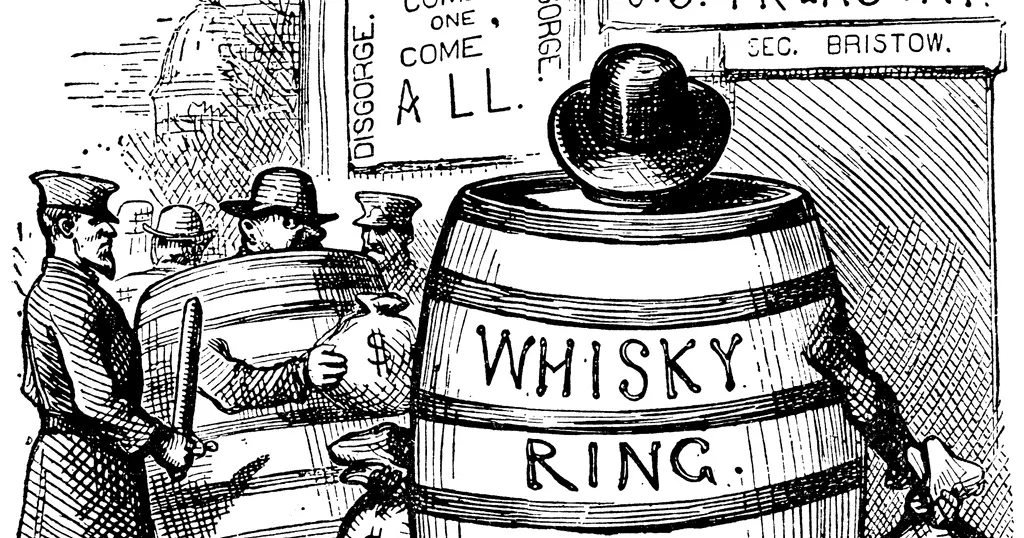When Americans elected Ulysses S. Grant as their president in 1868, they expected the iron-willed general who led the Union to victory in the Civil War. But beneath his stern military bearing lay a fatal flaw: an unshakable loyalty to unworthy men. That very flaw would bring his presidency to its knees through one of the most destructive political scandals of the 19th century—the Whiskey Ring Scandal.
An Administration Already on Shaky Ground
Grant’s administration began with high hopes but quickly became marred by controversy. As early as 1869, Grant’s associates Jay Gould and James Fisk manipulated the gold market in a plot known as Black Friday, causing financial chaos and raising questions about the integrity of those within his orbit.
That was only the beginning.
The Whiskey Ring: A Nationwide Conspiracy
By 1871, a far more insidious scheme was taking shape. Grant had dispatched General John McDonald, a close friend and trusted revenue official, to Missouri to shore up political support. Instead, McDonald built a criminal enterprise: the Whiskey Ring, a nationwide fraud scheme that robbed the federal government of millions.
Distillers, revenue agents, Treasury officials, and shopkeepers joined forces to dodge the federal liquor tax by faking records and bribing inspectors. The scale of the scheme was staggering: by 1873, the Ring was funneling an estimated $1.5 million annually (nearly $40 million today) into their own pockets instead of federal coffers.
🔗 Detailed timeline of the Whiskey Ring at the National Archives →
Benjamin Bristow and the Fight for Integrity
When Benjamin Bristow became Secretary of the Treasury in 1874, he vowed to root out corruption. He moved swiftly. Through undercover agents, surprise raids, and forensic audits, Bristow exposed a spiderweb of collusion stretching from St. Louis to Chicago and New Orleans.
The results were explosive: hundreds arrested, hundreds of thousands in evidence seized, and a direct line drawn to the heart of the executive branch.
Orville E. Babcock: A Trusted Friend or a Guilty Man?
Among the names that surfaced was Orville E. Babcock, Grant’s private secretary and confidant. Letters with coded language such as “Let no guilty man escape” hinted at his deep involvement. Yet when the scandal reached Babcock’s desk, Grant didn’t flinch.
Instead of letting the law run its course, the president acted. He fired the special prosecutor, defended Babcock personally, and even testified in court—an unprecedented move for a sitting U.S. president.
🧾 View Babcock’s trial documents in the Library of Congress →
Justice—But With a Price
Though Babcock was acquitted, the damage to Grant’s presidency was permanent. In total, 237 individuals were indicted, and 110 were convicted—an astounding number that included government officials at every level.
But to many Americans, the president’s interference on behalf of a loyal aide was proof of misplaced trust. He had chosen friendship over justice. His silence on the deeper institutional issues spoke louder than words.
Why the Whiskey Ring Scandal Mattered
This scandal wasn’t just a federal tax fraud case—it was a litmus test of executive character. It shattered the illusion of presidential immunity and exposed how easily honor can be compromised when personal ties override national duty.
The Whiskey Ring also changed public expectations of the presidency. No longer could Americans assume integrity by association. The public demanded a system that rewarded merit, not loyalty.
📜 Explore the long-term impact on civil service reforms via Smithsonian Magazine →
The Fallout: Grant’s Tarnished Legacy
Though Grant would go on to write one of the finest memoirs of any U.S. president and restore some of his public image, his time in office remains shadowed by this scandal. The Whiskey Ring became shorthand for cronyism, corruption, and the dangers of unvetted loyalty.
It prompted major civil service reforms, ultimately influencing the Pendleton Act of 1883—a key shift toward professionalizing government service and eliminating political patronage.
Frequently Asked Questions
What was the Whiskey Ring Scandal?
A criminal network of distillers and federal officials that evaded liquor taxes by falsifying records and bribing tax collectors.
Who were the key players?
General John McDonald, Orville E. Babcock, Treasury Secretary Benjamin Bristow, and President Grant were all central to the narrative.
How much money was lost?
Estimates suggest the ring stole about $1.5 million a year—more than $40 million in today’s dollars.
Did President Grant participate?
Grant was never directly involved but heavily criticized for defending Babcock and interfering with the investigation.
What reforms came after the scandal?
The scandal fueled momentum for the Pendleton Civil Service Reform Act, which aimed to reduce political corruption and patronage.
Why is this scandal still important today?
It’s a powerful reminder of how unchecked loyalty and lack of transparency can erode the public trust in democratic institutions.

